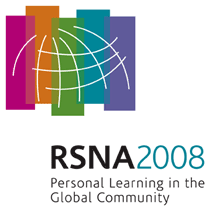
Abstract Archives of the RSNA, 2008
SSK07-09
Evaluation of Diagnostic Acceptability of Low Dose Abdominal CT Exams: An Alternative Approach
Scientific Papers
Presented on December 3, 2008
Presented as part of SSK07: Gastrointestinal (CT: Dual Energy/Innovations)
 Research and Education Foundation Support
Research and Education Foundation Support
Kavita Gulati MD, Presenter: Nothing to Disclose
Mannudeep Karanvir Singh Kalra MD, Abstract Co-Author: Research grant, General Electric Company
Michael Austin Blake MBBCh, Abstract Co-Author: Nothing to Disclose
Michael Stanley Gee MD, PhD, Abstract Co-Author: Nothing to Disclose
Mark Walters, Abstract Co-Author: Nothing to Disclose
Thomas Louis Toth, Abstract Co-Author: Employee, General Electric Company
Dushyant V. Sahani MD, Abstract Co-Author: Researcher, General Electric Company
Keith J. Dreyer DO, PhD, Abstract Co-Author: Employee, Perceptics, LLC
Medical Advisor, Perceptics, LLC
Medical Advisor, Agfa-Gevaert Group
Medical Advisor, FUJIFILM Holdings Corporation
Medical Advisor, General Electric Company
Medical Advisor, McKesson Corporation
Medical Advisor, AuntMinnie.com
Medical Advisor, AMICAS, Inc
Medical Advisor, Dynamic Imaging, LLC
Medical Advisor, Ascom Holding AG
Medical Advisor, Bracco Group
Medical Advisor, Merge Healthcare
Medical Advisor, Emageon, Inc
Medical Advisor, RCG HealthCare Consulting
Medical Advisor, Valley Radiology Medical Associates, Inc
Medical Advisor, The Elizabeth Wende Breast Clinic
Medical Advisor, ISCI
Medical Advisor, Siemens AG
Medical Advisor, Barco nv
Medical Advisor, Hue AS
Medical Advisor, Planar Systems, Inc
Medical Advisor, Vital Images, Inc
Medical Advisor, Commissure, Inc
Medical Advisor, TeraRecon, Inc
Medical Advisor, Mercury Computer Systems, Inc
Medical Advisor, IBM Corporation
Medical Advisor, Hewlett-Packard Company
Medical Advisor, EMC Corp
Medical Advisor, Phase Forward Incorporated
Medical Advisor, Winchester Systems, Inc
Medical Advisor, Dell Inc
Medical Advisor, Eastman Kodak Company
Medical Advisor, Amirsys, Inc
Medical Advisor, Reed Elsevier
Committee member, Diagnostic Imaging
Committee member, AuntMinnie.com
Committee member, Imaging Economics
Author, Springer Science+Business Media Deutschland GmbH
Shareholder, Microsoft Corporation
Shareholder, Intel Corporation
Shareholder, IBM Corporation
Shareholder, Hewlett-Packard Company
Shareholder, Dell Inc
Shareholder, General Electric Company
Shareholder, Siemens AG
Shareholder, Google Inc
et al, Abstract Co-Author: Nothing to Disclose
The purpose of our study was to assess the diagnostically acceptable level of radiation dose reduction for detection of subtle lesions on abdominal CT with the help of noise projection software and dose trainer application.
This IRB approved ongoing study included 40 patients (mean age:53.3, 22M: 18 F) with an abdominal CT study from (Jan’07-Feb’08), having subtle (<1 cm or isoattenuating with organ of origin) lesions. Set of routine DICOM images (kV 140, mA 50-500, slice thickness 5mm) showing pathology were extracted and were processed with the noise projection software to create five series of simulated 15% (mA 66-466, mean 259.9), 30% (mA 55-384, mean 211.9), 45% (mA 43-301, mean 167.3), 60% (mA 31-219, mean 121.8), 75% (mA 20-137, mean 76.8) dose reduction per case. All image series were viewed on the dose trainer (Win32 CSharp) application. Two abdominal radiologists, blinded to dose levels, independently reviewed the randomized standard and simulated low radiation dose images. Readers graded the image noise, diagnostic acceptability and lesion conspicuity. Objective noise and CT number were measured in each series with the same region of interest (ROI). Statistical analysis was performed using student’s t-test and Wilcoxon Signed rank test. Level of dose-reduction acceptable to both readers was assessed.
Average objective noise with 30% (20), 45% (21), 60% (24), 75% (30) reduced dose was significantly higher than standard dose series (16.7) (p<0.03). Total 45 lesions were identified on standard dose series with average lesion size of 1 cm. Both readers found that 45% reduced dose series was diagnostically acceptable but had more than usual noise in 25 of 45 lesions (p<0.0001), whereas diagnostic acceptability and image noise at 60%, 75% reduced dose series were suboptimal for 39 of 45 lesions (p<0.0001).
Use of noise projection software and dose trainer application suggests that CT radiation dose can be reduced by upto 45% without compromising the image quality and diagnostic acceptability.
The radiation dose, even if reduced to 45% of current protocols in abdominal CT studies, can be diagnostically acceptable for subtle lesions.
Gulati, K,
Kalra, M,
Blake, M,
Gee, M,
Walters, M,
Toth, T,
Sahani, D,
Dreyer, K,
et al, ,
Evaluation of Diagnostic Acceptability of Low Dose Abdominal CT Exams: An Alternative Approach. Radiological Society of North America 2008 Scientific Assembly and Annual Meeting, February 18 - February 20, 2008 ,Chicago IL.
http://archive.rsna.org/2008/6012725.html


 Research and Education Foundation Support
Research and Education Foundation Support